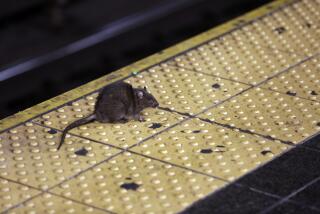A Rat-and-Mouse Chase to Reclaim Her Domain
- Share via
Ghosts and goblins may be the goose-pimply hype of Halloween night, but that’s mere child’s play. Gather ‘round, dim the lights and listen to a rat tale that will keep you awake all night....
My story begins simply enough. Opening the bathroom closet to replace some neatly folded linens recently, I observe droppings, randomly but effectively spread across my favorite floral, 200-count cotton sheets. My new chenille shams, my towels, my winter blankets--nothing has been left untouched.
Armed with sticky boards, poison pellets and peanut butter-baited traps, I lie in wait, determined to catch my prey. But he is smart, cunning and amazingly agile. Under cover of darkness, he reappears and feasts on a slice of melon left on the kitchen counter, evading the traps along the room’s perimeter.
Three days into the hunt, I must rest. But as I begin to doze, he surfaces ... this time at the foot of my bed. Professionals, both exterminators and licensed therapists, are called in to assist. My rat is trapped, bagged and removed from the premises.
As for me, I’m still in recovery.
The rodent corpse was never officially identified, although best estimates indicate it was a black rat, or Rattus rattus , known to locals as a roof rat or tree rat. Southern California is also home to the larger brown rat, a.k.a. Rattus norvegicus , a.k.a. Ben. Our warm climate, lushly landscaped yards and abundant supply of fresh fruit are the rat equivalent of five-star digs--for which they don’t, I might add, pay a thing.
Brown or black, rats are, in a word, nasty. A two-pound rat can squeeze through an opening as small as a half dollar, swim a half-mile and tread water for three hours, making the toilet a possible point of home invasion.
Not scared yet?
A rat can leap three feet vertically, and, if threatened or cornered, has been known to jump at its aggressor.
Rats also carry disease and destroy property. Their teeth are extremely powerful and grow continually. They will gnaw on anything from wood to concrete to keep their incisors trim. And if you haven’t already added Vector Control to the speed dial, ponder this: Rats can reproduce eight to 12 young every 21 days.
The rat news is not all horrible. L.A.’s rodents tend to carry less disease and be less aggressive than their Eastern cousins, according to Frank Hall, chief of vector control in the Los Angeles Department of Public Health. “If you face a rat in L.A., he’s not going to hiss back at you,” Hall said. “In more compacted, urban centers, man and animal are going to face off more often.”
Hall said his department responds to almost 10,000 rodent-related calls annually, offering information, control strategies and poison when needed. And not to blame the victim, but humans are frequently at fault. “Often we’re just feeding the rodent population without knowing it,” Hall said. Improperly contained garbage, pet food left out at night, leaky faucets, fruit trees--all lure rats to even the most pristine neighborhoods.
Rats, like most life forms, have always been determined to find three things: food, shelter and water. And in our heavily populated urban centers and greened suburban sprawl, they enjoy a surplus of goods, according to Bruce Colvin, a Boston-based expert on environmental management and rodent control who has literally sat among the rats in order to study rat behavior and rat feeding patterns. What he has discovered is almost too horrifying to repeat: “People are providing the food, and rats are providing the sex.”Colvin aims, in an Oprah-esque way, to empower people like me with information so they can conquer their rodent fears and implement effective rat control strategies. “Rat problems are rarely addressed until they reach critical mass. You never hear of a bike-a-thon for rat control, but standing on top of a kitchen stool never works, either. Rats climb stools, too.”
According to Colvin, if you have a rat in your house and you can determine its food source, you can solve the problem. He suggests baiting traps with pepperoni.
Now, here is the bone chilling part of the story: Some people love rats. Some people think a rat makes the perfect pet. And even though a pet rat and a sewer rat are related (both are from the Norway rat family, and how I wish they’d stayed there), the domesticated rat has long since lost its wild traits and habits. Through a century of careful breeding, rat fanciers have developed varieties such as the black-and-white spotted Dalmatian and the curly-haired Siamese. These new and improved rats are very clean. They don’t stink, and they don’t bark, according to Karen Robbins, founder and president of the American Fancy Rat and Mouse Assn. based in her Winnetka home.
The association organizes events where rodents compete in categories similar to those in dog and cat shows. (The club’s next event is scheduled for Nov. 10 at the Woodcrest Community Center in Riverside.)
The other day, Robbins greeted me at her home in a T-shirt that warns “Rodents Rule.” Four large male rats played in a long glass tank that covers the top of her living room coffee table.
The only disadvantage to having pet rats, she admitted, is their 2-to 21/2-year life span.
“You get attached,” she said, “and they die.” I tried to seem sympathetic.
To my untrained eye, fancy rats bear a striking resemblance to their free-range brothers and sisters. This makes it difficult for me to imagine becoming emotionally attached. Robbins leads me into a small, lab-like building in her backyard, her “rattery,” where she breeds rats as a hobby. Given my own experience, it was like immersion therapy. My heart beat a little faster. She showed me a litter of 3-day-old baby rats, or “kittens.” They were hairless, pink, almost cute; but in a matter of weeks, they’ll be ... rats.
I thought investigating rats would assuage my anxieties, that writing about them would provide a catharsis of sorts--like admitting to head lice or ringworm. Progress has been made. Before turning in at night, every crumb is swept from the dinner table, the garbage is tightly sealed and the dog assumes his post as sentinel at the foot of the bed.
I think I’m ready to come down from the kitchen stool now and reclaim my domain.


